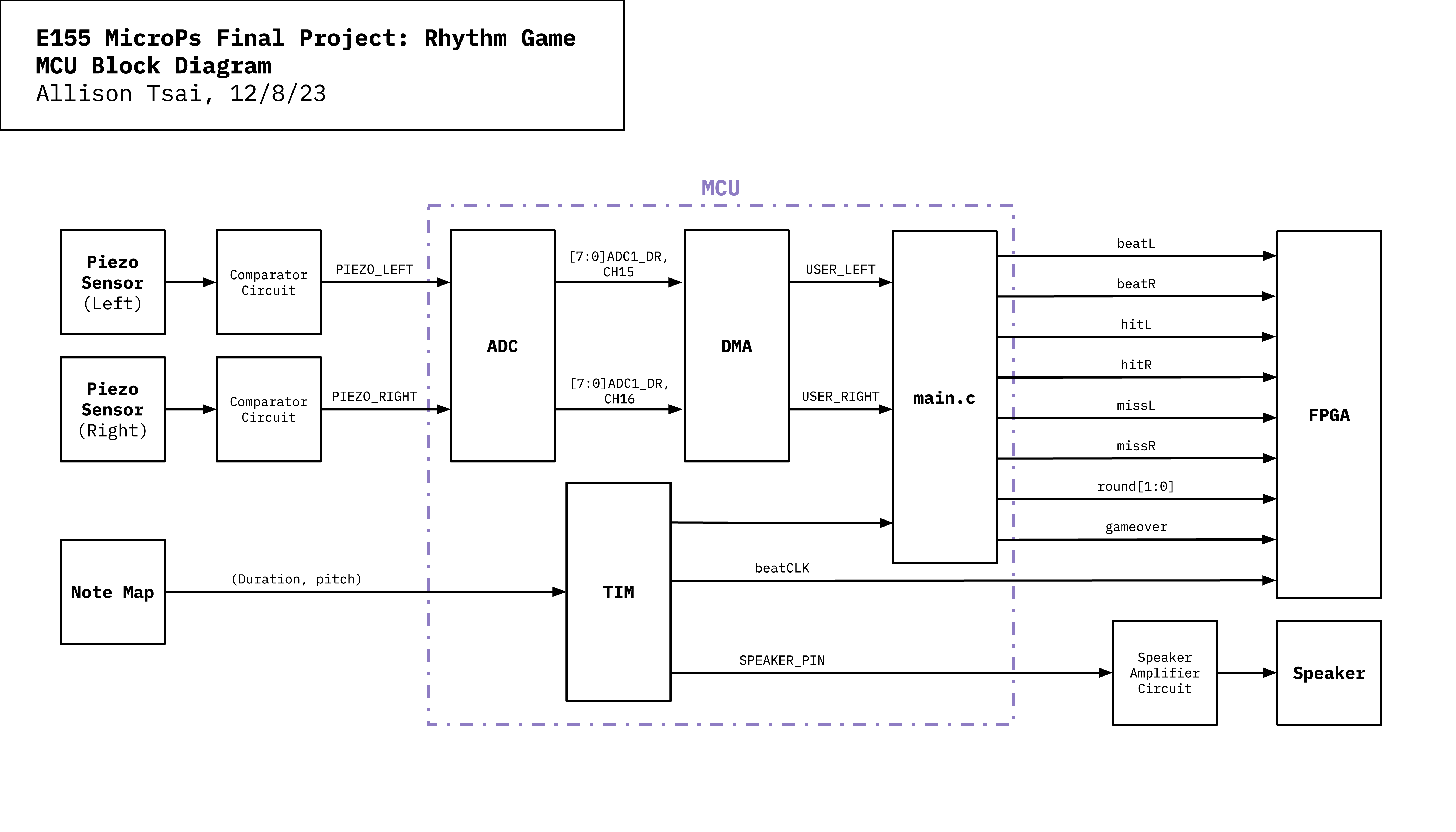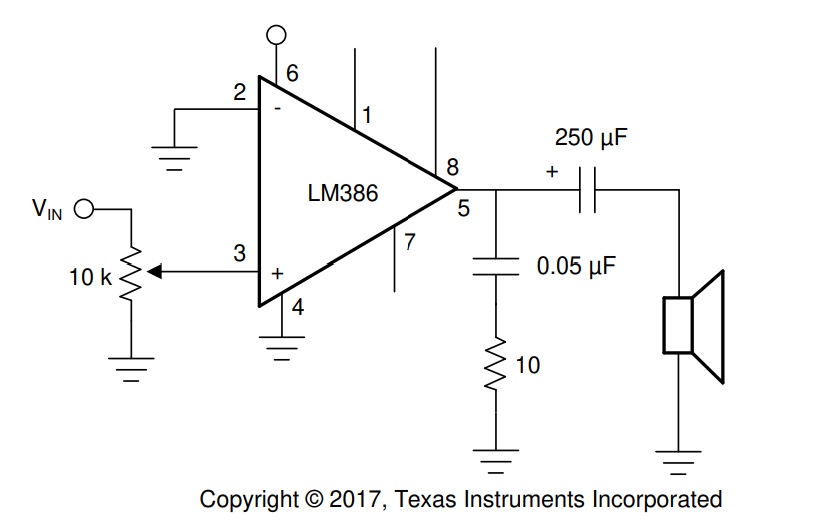MCU Design
New Hardware
The new hardware used was Adafruit’s small enclosed piezo sensors. Piezo devices can convert mechanical energy into electrical energy or vice versa. Thus, they were used to “sense” user inputs by translating vibration into readable voltage.
The two piezo sensors were attached to back of two drum pads. These pads were laser cut out of 1/8” plywood and screwed onto a circular base with stands using 10-24 button head screws and hex nuts. Both the base and stands were machined using a vertical bandsaw and were made from 1/2” plywood. To isolate the vibrations from the pads, rubber washers and spacers were placed between the base and the pads. The spacers were 3D printed out of TPU. The CAD for the drum is available here.
MCU System Design
 The MCU uses three peripherals:
The MCU uses three peripherals: ADC, DMA, and TIM. The ADC peripheral is responsible for converting the analog voltage from the piezo sensors to digital. The DMA peripheral is responsible for data transfers between the ADC registers and a temporary memory address. The TIM peripheral is responsible for generating the beat clock, the frequency waveform that goes to the speaker, and a duration timer. (See FPGA section for the definitions of all the outputs going from the MCU to the FPGA)
ADC and DMA
The piezo sensors were connected to a comparator circuit that sends 3.3 V to the ADC pin if the sensor generates a voltage above 1.1 V. The sensor is also connected in parallel with a resetting resistor that has a value of 10 MΩ. When the generated voltage has dissipated to a value below the threshold, the current flows through the resetting resistor, helping to discharge any leftover voltage. When the ADC pin receives the 3.3 V, the data register generates a value anywhere between 0 and 255. For both sensors, the data register generates a value of at least 180.
To process both sensors, the ADC peripheral was configured such that there would be continuous conversions with an 8-bit resolution; ADC would scan the right sensor pin first (channel 16) and then the left sensor pin (channel 15). Each channel was set to have a sampling time of 2.5 ADC clock cycles.
Since there is more than one channel being converted at a time, the DMA peripheral was set up to manage these conversions. For this, the DMAEN and EOCIE bits were set to 1 such that channel interrupts and DMA mode was enabled for ADC. After a channel has been converted, the channel interrupt is be written to 1, signaling a DMA request to be generated. This allows the transfer of the converted data from the ADC_DR register to a specified temporary memory address.
TIM
To match the FPGA, the MCU’s system clock was set to be 24 MHz. Three timers were used in this design: TIM2, TIM15, and TIM16. Both TIM2 and TIM15 were configured to their PWM mode, where a signal is generated with a frequency determined by the value of the auto reload register (TIMx_ARR) and a duty cycle determined by the value of the capture/compare register (TIMx_CCRx). For simplicity, both waveforms have a duty cycle of 50%. TIM2 represents the duration of each sixteenth note; this is the beat clock. TIM15 represents the frequency of the note; this is the speaker pin. TIM16 also represents the duration of each sixteenth note, but instead of being configured into an output waveform, it was used in a looping logic.
There is an amplifier circuit between the speaker pin and the speaker because the current draw of the speaker is greater than the max current output of the MCU pin. The internal gain of the amplifier is 20 and the minimum gain needed is 10, thus the circuit was wired according to the schematic below, excluding any resistor and bypass capacitors.

main.c
The main.c file contains all the logic for the rhythm game. The game progresses according to a note_map, which is an integer array of arrays containing the note duration and frequency. For this project, this note_map was written to play the Tetris theme which has a time signature of 4/4. Because of the time signature, each note was broken down into sixteenth notes such that a steady beat clock can be sent to the FPGA.
The MCU progresses through the note_map using a while-loop nested in a for-loop. The while-loop checks if TIM16 has reached the note’s playing time. If the playing time is over, then the for-loop iterates through the note_map. If the playing time is not over, then the MCU checks if the player has hit the drum. If the player has hit the drum, then the MCU checks if there is a beat that had to be played using the beat_map. The beat_map is an integer array containing the same number of arrays as the note_map except these arrays consist of 3 elements: (1) whether or not there is a beat, (2) if there is a left beat, and (3) if there is a right beat. If the 0th element in the array is 0—in other words, there is no beat—then the first and second element is always be 0. There are a few possibilities if there is a beat:
- If the user plays the beat correctly, then they earn a point and that beat in the map is written to 0. This was done to avoid double counting. Additionally, the MCU writes 1 to
hitLand/orhitR. - If the user plays the beat incorrectly or if they miss a beat, then the MCU writes 1 to
missLand/ormissR.
If they user hits the drums when there’s no beat, nothing happens; they are not penalized. At the beginning of each note_map iteration (for-loop), the MCU writes 0 to hitL, hitR, missR, and missL. It also sends the left and right beats from the beat_map to beatL and beatR. Since it takes some time for the notes to fall down on the display, there is an added two measures of silent delay in the note_map. This is the foundation of the game logic.
To implement rounds and increasing speeds, the basic game logic is nested in another while-loop that tracks the round number. At the beginning of this while-loop, the MCU writes the round number to round[1:0]. At the end of the while-loop, it checks the user score against a threshold. If the user score does not meet the threshold, then the MCU breaks out of this loop and writes 1 to gameover. If the user score does meet the threshold, then the MCU increments the round number by 1 and decreases the duration of the notes by a factor of 1/6. Additionally, it rewrites the beat_map using a copy of the beat_map and the function memcpy. If the user makes it to the third round and passes the point threshold, then the MCU writes 3 to round[1:0] to tell the FPGA to display the “win” screen.